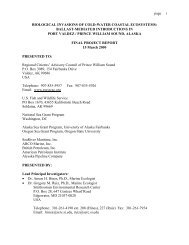Harmful Non-Indigenous Species in the United States - Aquatic ...
Harmful Non-Indigenous Species in the United States - Aquatic ...
Harmful Non-Indigenous Species in the United States - Aquatic ...
You also want an ePaper? Increase the reach of your titles
YUMPU automatically turns print PDFs into web optimized ePapers that Google loves.
24 I <strong>Harmful</strong> <strong>Non</strong>-<strong>Indigenous</strong> <strong>Species</strong> <strong>in</strong> <strong>the</strong> <strong>United</strong> <strong>States</strong>(83) (box 4-A). The pet <strong>in</strong>dustry, along withportions of <strong>the</strong> zoological and scientfic communities,spearheaded opposition <strong>in</strong> <strong>the</strong> 1970s (55).Marshall Meyers, general counsel for <strong>the</strong> PetIndustry Jo<strong>in</strong>t Advisory Council, articulates <strong>the</strong><strong>in</strong>dustry’s cont<strong>in</strong>u<strong>in</strong>g opposition to regulationsviewed as overly restrictive, vague, or poorlyjustified (14), as <strong>the</strong>y found previous clean listproposals. On <strong>the</strong> o<strong>the</strong>r hand, <strong>the</strong> pet <strong>in</strong>dustryrecently jo<strong>in</strong>ed environmental groups <strong>in</strong> support<strong>in</strong>gtighter regulation of importation of wildcaughtbirds.11Both clean and dirty lists require determ<strong>in</strong><strong>in</strong>gwhe<strong>the</strong>r species pose acceptable risks. Formaldecisionmak<strong>in</strong>g protocols, risk analysis, costbenefitanalysis, and o<strong>the</strong>r techniques attempt toaccomplish this goal (ch. 4). Each has advantagesand disadvantages. For example, protocols like<strong>the</strong> American Fisheries Society’s for <strong>the</strong> releaseof fish (51) represent a high level of decisionmak<strong>in</strong>grigor and best suit <strong>the</strong> most potentially riskytypes of <strong>in</strong>troductions. Typically, <strong>the</strong>se methodsrequire large amounts of highly technical <strong>in</strong>formationand are <strong>the</strong>refore demand<strong>in</strong>g <strong>in</strong> f<strong>in</strong>ancialand scientific terms. Also, <strong>the</strong>se methods arecontroversial because <strong>the</strong>ir usefulness has notbeen established clearly.No s<strong>in</strong>gle method is ideal for assess<strong>in</strong>g allFederal and federally funded <strong>in</strong>troductions ofnon-<strong>in</strong>digenous fish and wildlife. However, formaldecisionmak<strong>in</strong>g methods designed to morecarefully assess and decrease risks are consideredto be prudent alternatives to bann<strong>in</strong>g all potentiallyrisky <strong>in</strong>troductions (83). Congress couldrequire that agencies develop and adopt ei<strong>the</strong>r arecognized decisionmak<strong>in</strong>g protocol or ano<strong>the</strong>rformal and rigorous method suited to <strong>the</strong>irsituations. This was <strong>the</strong> approach taken <strong>in</strong> <strong>the</strong>proposed <strong>Species</strong> Introduction and Control Act of1991 regard<strong>in</strong>g non-<strong>in</strong>digenous fish and wildlife.12DEFINING NEW STATE ROLES IN FISH ANDWILDLIFE INTRODUCTIONOption: Congress could address weaknesses <strong>in</strong>some <strong>States</strong>’ fish and wildlife laws byimplement<strong>in</strong>g national m<strong>in</strong>imum standards.These standards would provide legal authorityto regulate harmful NIS and be l<strong>in</strong>ked tofund<strong>in</strong>g for <strong>States</strong> to implement <strong>the</strong>m.Option: Alternately, Congress could encouragewider adoption of a federally developed modelState law to make legal authority among <strong>States</strong>more comprehensive.The strength of <strong>the</strong> U.S. Federal system is that<strong>the</strong> 50 <strong>States</strong> provide a test<strong>in</strong>g ground for newideas. Such new ideas turn up <strong>in</strong> <strong>the</strong> exemplaryapproaches discussed <strong>in</strong> chapter 7. On <strong>the</strong> o<strong>the</strong>rhand, federalism leads to duplication of effortsand highly variable, and sometimes conflict<strong>in</strong>g,regulations (72). This has been <strong>the</strong> case fornon-<strong>in</strong>digenous fish and wildlife.<strong>States</strong>’ standards vary considerably regard<strong>in</strong>gwhich species and groups are regulated and howcarefully <strong>the</strong>y are regulated; many State efforts toregulate importation, possession, <strong>in</strong>troduction,and release are <strong>in</strong>adequate (ch. 7) (55). In somecases, <strong>the</strong> weaknesses of State programs stemfrom <strong>in</strong>complete legal authority.The Lacey Act leaves decisions on almost all<strong>in</strong>tentional <strong>in</strong>troductions of fish and wildlife to<strong>the</strong> <strong>States</strong>; only <strong>the</strong> relatively few organisms on<strong>the</strong> list of <strong>in</strong>jurious wildlife are prohibited. Thus,correct<strong>in</strong>g problems would entail full exercise ofState prerogatives (83). However, Federal programssupport many State-sponsored <strong>in</strong>troductions,so <strong>the</strong> Federal Government has a strong<strong>in</strong>terest <strong>in</strong> this area.A variety of approaches could be used toencourage improved State performance. Federalpre-emption of State NIS laws is unlikely to bejustifiable or politically feasible. Two more11 me wild Bl~d Comenation Act of 1992, ~blic ~WJ 102-440, Tifle 1, Smtion 102, Oct. 23, 1992; 106 stN. 2224.1’2 H.R. 5852, <strong>in</strong>troduced by Rep. H. James Saxton.














